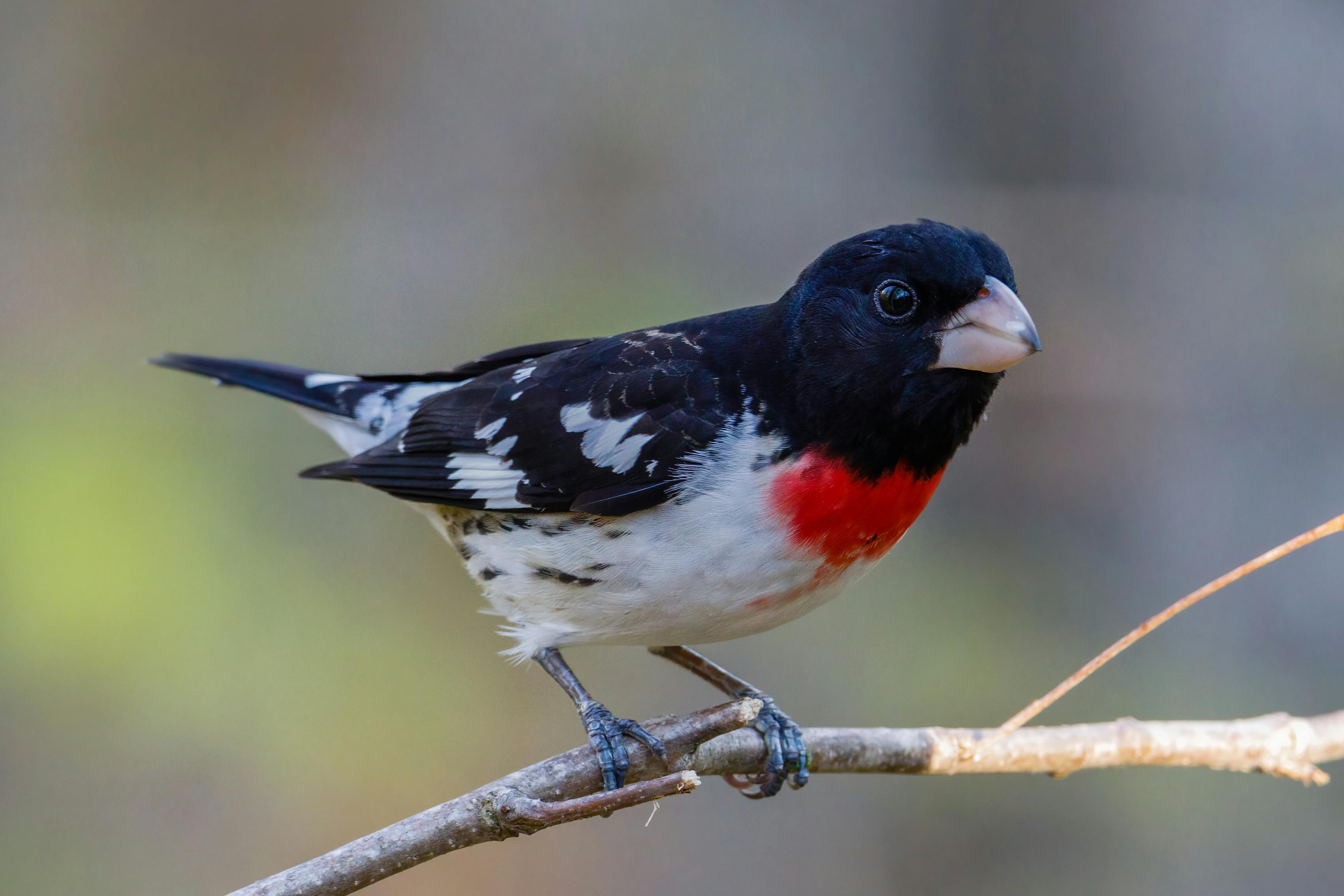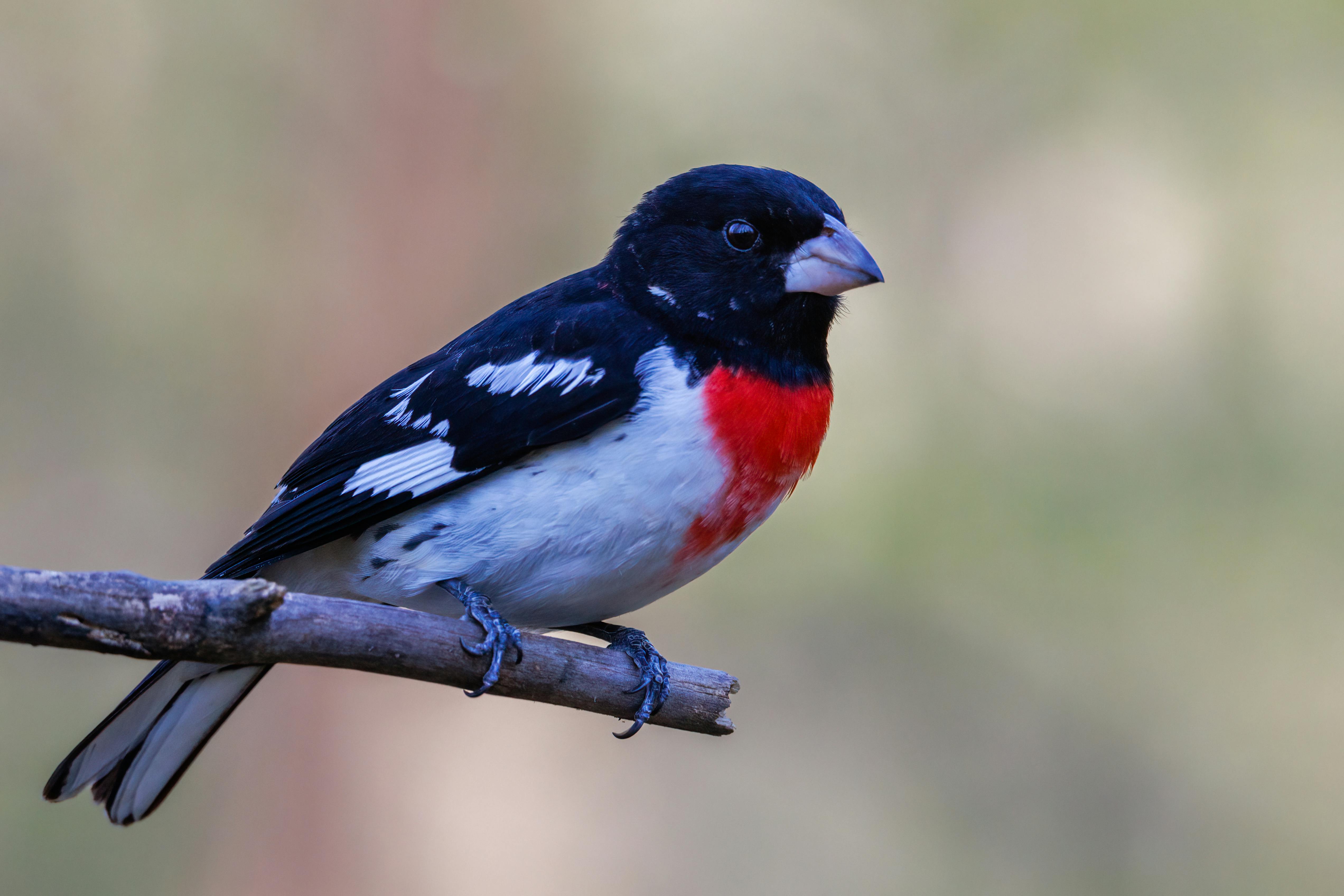The Rose-breasted Grosbeak (Pheucticus ludovicianus) is a medium-sized songbird belonging to the family Cardinalidae. It is native to North America and can be found throughout much of the continent. It is a colorful bird, with males having bright rose-red chests and black heads while females are brownish in color with a light-colored throat. The Rose-breasted Grosbeak is a popular backyard bird, often seen perched atop trees or thick shrubs. Its diet consists mainly of insects, fruits, and seeds which it finds either on the ground or in midair when it forages. The Rose-breasted Grosbeak also has an impressive repertoire of songs which are used by both males and females during breeding season.The Rose-breasted Grosbeak is a medium-sized passerine bird in the family Cardinalidae. It is approximately 20–23 cm (7.9–9.1 in) long, with a wingspan of 28–33 cm (11–13 in). The male has a black head and wings, with a white patch on the shoulder, and a bright red breast, while the female is drabber and lacks the red breast. Both sexes have white wing bars, and a yellow conical bill. It lives in deciduous forests of eastern North America and northern Mexico during the summer months, migrating to Central America, northern South America and southern Mexico for winter. Its diet consists mostly of seeds, insects and berries.
Contents
Physical Characteristics
The Rose-breasted Grosbeak (Pheucticus ludovicianus) is a medium-sized songbird, measuring 6 to 7 inches in length and weighing around 1.1 ounces. It has a short, stout bill and long wings that are pointed at the tips. The male is brightly colored with a black head and neck, white underparts, and rose-red breast. The female has duller colors with grayish-brown feathers and yellowish underparts. Both males and females have white wing bars on the upper wings and white tail patches on the lower wings.
Habitat
The Rose-breasted Grosbeak is primarily found in deciduous woodlands, such as oak forests, but can also be found in shrubland and open fields. They migrate to southern states in the winter months when their food sources become scarce in more northern climates.
Diet
Rose-breasted Grosbeaks feed mainly on insects, including caterpillars, beetles, and grasshoppers; as well as fruits such as cherries, elderberries, dogwood berries, wild grapes, raspberries, blueberries, and mulberries. They are known for their ability to crack open sunflower seeds with their bills so they can eat the inner kernel.
Behavior
Rose-breasted Grosbeaks are usually seen alone or in pairs during breeding season but may form small flocks during migration or winter months when food sources are scarce. They spend much of their time foraging on the ground or clinging to tree trunks while searching for food items. The males are known for their beautiful songs that they sing from atop branches during breeding season.
Habitat and Distribution of Rose-breasted Grosbeak
The Rose-breasted Grosbeak (Pheucticus ludovicianus) is a species of passerine bird found in North America. It breeds in deciduous or mixed forests across most of Canada and the northern United States. During the winter months, it migrates south, primarily to Mexico and Central America. Its preferred habitats include open woodlands, second growth forests, riparian areas, and shrubland. It is also sometimes found in suburban areas with dense vegetation.
Rose-breasted Grosbeaks are most common in coniferous forest habitats during the breeding season. During this time, they often make their nests in trees or shrubs near a clearing where they can feed on insects and berries. In the winter months, they migrate south to tropical rainforests and other warm habitats with abundant food sources such as fruit trees and shrubs.
Rose-breasted Grosbeaks are found throughout North America, from Alaska to Newfoundland, through the Midwest United States, down into Central America and Mexico. They are seasonal migrants that move further south during the winter months to find food sources when temperatures drop. They have also been known to wander further east into Europe on rare occasions.
Physical Adaptations
Rose-breasted Grosbeaks have several physical adaptations that help them survive in their habitat. They have a large, strong beak which helps them to crack open hard shells and break into fruits. Their feathers are thick and waterproof, helping to keep them warm and dry even in the coldest weather. They also have a long tail which helps them to keep their balance when flying. Lastly, their feet are well adapted for perching on branches and they can move quickly while hopping from branch to branch.
Behavioral Adaptations
Rose-breasted Grosbeaks are migratory birds, meaning they travel long distances from one area to another depending on the season. During the winter months, they migrate southward in search of warmer climates with plenty of food sources. In the springtime, they return northward and breed in their original habitats. Breeding season is an important time for Rose-breasted Grosbeaks as it is when many of their behaviors show up, such as singing and mating displays.
Dietary Adaptations
Rose-breasted Grosbeaks feed on a variety of foods including seeds, fruits, insects, and other small animals. They use their strong beaks to crack open hard shells and break into fruits. They also use their sharp talons to catch small prey such as insects or amphibians. During breeding season they feed mainly on insects which provide important nutrients for reproducing adults and young chicks.
Mating Adaptations
Rose-breasted Grosbeaks have several mating adaptations that help them find suitable mates during the breeding season. The males are brightly colored with distinct black and white stripes along the chest which helps attract potential partners. The males also sing complex songs to try and impress females who will then choose a mate based on these vocalizations. Lastly, during mating displays the male will puff out his feathers in order to appear larger than he actually is in hopes of attracting females who prefer larger males over smaller ones.
Diet of Rose-breasted Grosbeak
The diet of the Rose-breasted Grosbeak consists mainly of seeds, berries, and other fruits. They will also feed on insects and spiders. In the summertime, they may consume more insects than fruit. During the winter months, they may switch to a diet that is predominantly fruit-based. Rose-breasted Grosbeaks have been known to come to bird feeders and eat sunflower seeds, peanuts, suet, cracked corn and other types of seed mixes.
Insects are an important part of their diet during the breeding season. Caterpillars, beetles, and ants make up the majority of their insect consumption. They will also feed on grasshoppers, crickets and millipedes when available. Spiders are also consumed by this species during the breeding season for added protein.
Fruits are also a large part of their diet throughout the year. Berries such as raspberries, blackberries, mulberries and blueberries are frequently consumed in autumn when these fruits are in season. They will also eat cherries and grapes if given the opportunity. During winter months when fruit is scarce, they turn to tree buds for sustenance.
In addition to these items, Rose-breasted Grosbeaks may eat grains as well as nectar from flowers in springtime. These birds have also been observed consuming sap from trees as well as ground-dwelling invertebrates such as earthworms and snails on occasion.

Breeding and Reproduction of Rose-breasted Grosbeak Animal
The Rose-breasted Grosbeak (Pheucticus ludovicianus) is a species of passerine bird in the family Cardinalidae. They are native to North America, and are primarily found in the eastern parts of Canada and the United States. The males are distinguished by their brightly colored plumage, while females are more muted in coloration. The Rose-breasted Grosbeak typically breeds during the summer months, with pairs typically forming in late spring and early summer. Males will aggressively defend their breeding territories from other males, and will court potential mates with song and elaborate displays.
Once a female is chosen, nesting begins shortly thereafter. Females alone build nests near the ground in shrubs or trees. The nest is made out of grasses, twigs, leaves, bark strips, mosses, lichens and feathers. Females lay between two to six eggs which she incubates alone for 12–13 days until they hatch. Both parents then take turns feeding and caring for their young until they fledge at around 12–14 days old. After another 10–14 days on the ground learning to feed themselves, young Rose-breasted Grosbeaks will eventually take flight from their natal area to begin their life as an adult bird.
Appearance
The Rose-breasted Grosbeak (Pheucticus ludovicianus) is a songbird that is native to Northern and Central America. It has a black head, white cheeks, and a pink chest. The back of its body is grey, and it has a large yellow bill. Its wings are black with white bars and its tail is long, black and white. The female Rose-breasted Grosbeak is duller in color than the male. Both sexes have long legs that are pinkish-gray in color.
Behavior
The Rose-breasted Grosbeak can be found in deciduous forests, woodlands, and open areas. It prefers areas with trees or shrubs for nesting purposes. During breeding season it becomes very territorial and defends its territory aggressively against other birds. It will also chase away intruders from its nesting area. The Rose-breasted Grosbeak’s diet consists of insects, seeds, grains, and fruit. It has been known to feed on bird feeders if they are available.
Lifespan
The average lifespan of the Rose-breasted Grosbeak is between 6-10 years in the wild. In captivity, they can live up to 15 years with proper care and nutrition. The oldest recorded Rose-breasted Grosbeak lived for 17 years in captivity.
Conservation Status of Rose-breasted Grosbeak Animal
The Rose-breasted Grosbeak (Pheucticus ludovicianus) is a species of bird belonging to the Cardinalidae family. It is a migratory species, breeding in North America and wintering in Central America and northern South America. The global population of this species is estimated to be 8 million individuals, with the majority of birds found in the United States and Canada. The Rose-breasted Grosbeak is listed as a species of Least Concern on the IUCN Red List, as its population appears stable. However, it has been noted that local populations may be declining due to habitat loss and degradation.
This species is also listed on CITES Appendix II, which means that it is not currently threatened with extinction but may become so unless trade in its parts or derivatives is closely controlled. The Rose-breasted Grosbeak is also protected by various national laws in the countries where it breeds or passes through during migration. For example, it is protected by the Migratory Bird Treaty Act in the United States and Canada, which prohibits hunting, capture or killing of these birds.
In addition to legal protection, conservation efforts have been undertaken for this species at both local and international scales. Habitat protection for nesting sites and wintering grounds has been identified as one of the main priorities for conservationists working with this species. Additionally, educational campaigns have been used to raise awareness about this bird and promote public engagement in conservation efforts aimed at preserving its habitats.

Conclusion
The Rose-breasted Grosbeak is an extraordinary bird that is widely distributed throughout North America. This species of songbird is a favorite among birdwatchers and backyard birders alike due to its unique coloration and melodious song. The Rose-breasted Grosbeak is a hardy species that can adapt to many different habitats, making it an important part of the North American avian community. Furthermore, this species is known for its high level of parental care and attentiveness, making it an important part of the breeding population in many areas. The Rose-breasted Grosbeak offers a great opportunity for birdwatchers and backyard birders to observe a beautiful species in their own backyard.
Overall, the Rose-breasted Grosbeak is an incredible species that has much to offer both ornithologists and casual observers alike. From its striking coloration to its melodious song, the Rose-breasted Grosbeak is truly a magnificent creature that deserves appreciation and admiration from all who have the privilege of witnessing it in its natural habitat.

0 Comments